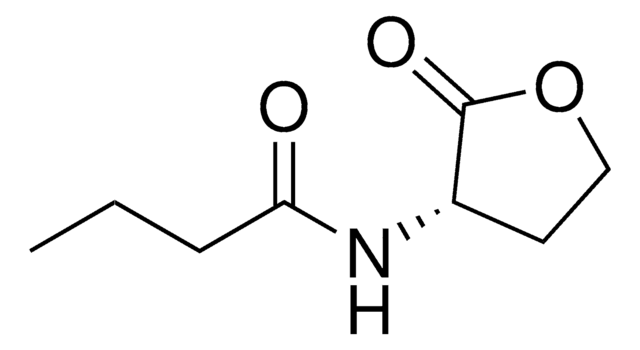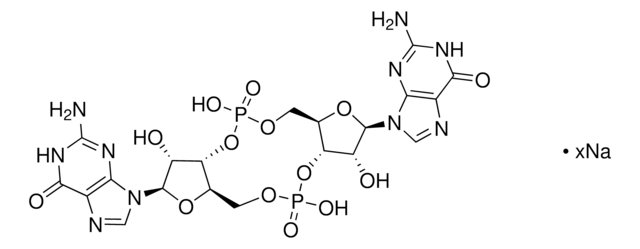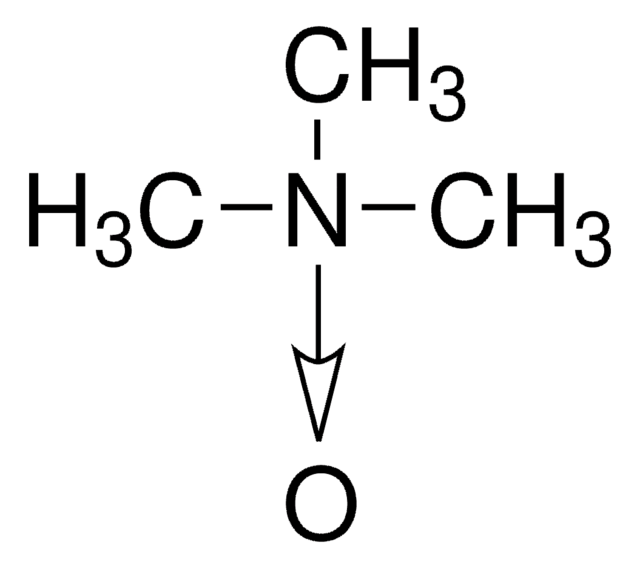Alle Fotos(1)
Wichtige Dokumente
42052
cis-11-Methyl-2-dodecensäure
≥90.0% (HPLC)
Synonym(e):
DSF, Diffusible signal factor
Anmeldenzur Ansicht organisationsspezifischer und vertraglich vereinbarter Preise
Alle Fotos(1)
About This Item
Empirische Formel (Hill-System):
C13H24O2
CAS-Nummer:
Molekulargewicht:
212.33
MDL-Nummer:
UNSPSC-Code:
12352106
PubChem Substanz-ID:
NACRES:
NA.25
Empfohlene Produkte
Qualitätsniveau
Assay
≥90.0% (HPLC)
Lagertemp.
−20°C
SMILES String
CC(C)CCCCCCC\C=C/C(O)=O
InChI
1S/C13H24O2/c1-12(2)10-8-6-4-3-5-7-9-11-13(14)15/h9,11-12H,3-8,10H2,1-2H3,(H,14,15)/b11-9-
InChIKey
SNTXNGAQYNSTHI-LUAWRHEFSA-N
Anwendung
Diffusible signal factor (cis-11-methyl-2-dodecenoic acid, DSF) is used to study cell-cell communication by pathogenic bacteria such as Xanthomonas campestris pv. Campestris (Xcc). DSF is involved in the synchronization of virulence gene expression and biofilm dispersal.
Verpackung
Bottomless glass bottle. Contents are inside inserted fused cone.
Signalwort
Warning
H-Sätze
P-Sätze
Gefahreneinstufungen
Aquatic Chronic 2 - Eye Irrit. 2 - Skin Irrit. 2
Lagerklassenschlüssel
10 - Combustible liquids
WGK
WGK 3
Flammpunkt (°F)
Not applicable
Flammpunkt (°C)
Not applicable
Hier finden Sie alle aktuellen Versionen:
Besitzen Sie dieses Produkt bereits?
In der Dokumentenbibliothek finden Sie die Dokumentation zu den Produkten, die Sie kürzlich erworben haben.
Kunden haben sich ebenfalls angesehen
Heather Ohly et al.
Journal of toxicology and environmental health. Part B, Critical reviews, 19(7), 305-343 (2016-11-03)
Attention Restoration Theory (ART) suggests the ability to concentrate may be restored by exposure to natural environments. Although widely cited, it is unclear as to the quantity of empirical evidence that supports this. A systematic review regarding the impact of
Kaku Goto et al.
Oncotarget, 7(46), 74987-74999 (2016-09-08)
We recently described that the anti-apoptotic AMPK-related kinase, SNARK, promotes transforming growth factor (TGF)-β signaling in hepatocellular carcinoma (HCC) cells, as a potentially new therapeutic target. Here we explored FDA-approved drugs inhibiting the enzymatic activity of SNARK, using an in
Olubukayo-Opeyemi Oyetayo et al.
European journal of pharmaceutical sciences : official journal of the European Federation for Pharmaceutical Sciences, 97, 151-157 (2016-11-21)
Solvents used for therapeutic proteins in downstream processing and in formulations often contain stabilizing additives that inhibit denaturation and aggregation. Such additives are mostly selected based on their positive effect on thermal stability of the protein, and are often derived
Robert P Ryan et al.
Proceedings of the National Academy of Sciences of the United States of America, 107(13), 5989-5994 (2010-03-17)
RpfG is a paradigm for a class of widespread bacterial two-component regulators with a CheY-like receiver domain attached to a histidine-aspartic acid-glycine-tyrosine-proline (HD-GYP) cyclic di-GMP phosphodiesterase domain. In the plant pathogen Xanthomonas campestris pv. campestris (Xcc), a two-component system comprising
Anita Sarkar et al.
Nature communications, 9(1), 1956-1956 (2018-05-18)
Furin cleavage of the HIV envelope glycoprotein is an essential step for cell entry that enables formation of well-folded, native-like glycosylated trimers, releases constraints on the fusion peptide, and limits enzymatic processing of the N-glycan shield. Here, we show that
Unser Team von Wissenschaftlern verfügt über Erfahrung in allen Forschungsbereichen einschließlich Life Science, Materialwissenschaften, chemischer Synthese, Chromatographie, Analytik und vielen mehr..
Setzen Sie sich mit dem technischen Dienst in Verbindung.








